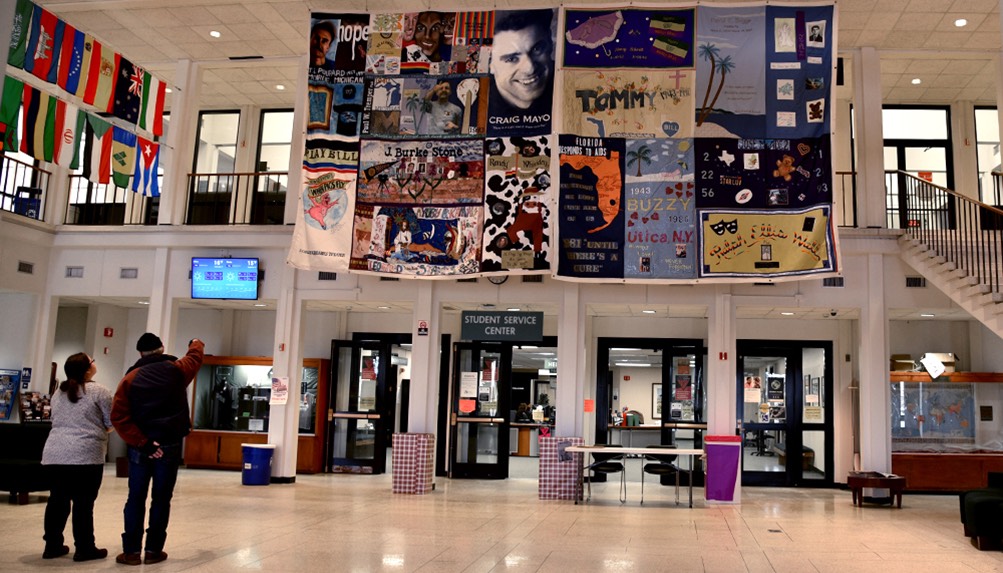
Observed each year on December 1, World AIDS Day was started in 1988 as an opportunity for people all over the world to unite in the fight against human immunodeficiency virus (HIV), show their support for people with HIV, and remember those who have died from an HIV-related illness.
HIV is a virus that attacks the body’s immune system. If untreated, it can lead to AIDS (acquired immune deficiency syndrome). Globally, there are an estimated 38 million people who have the virus. More than 35 million people have died of HIV or AIDS, making it one of the most destructive pandemics in history. There is no effective cure; however, people with HIV who get effective treatment can live long, healthy lives and protect their partners.

World AIDS Day 2025 at MVCC
AIDS Memorial Quilt display and ceremony
For the past several years in honor of World AIDS Day, we have displayed panels from the AIDS Memorial Quilt at our campuses and to honor and remember the lives lost to the disease. We also hold a brief ceremony at our Utica Campus in their memory and to uplift continuing efforts to prevent and treat HIV locally and worldwide.
- AIDS Quilt display: Monday-Friday, Dec. 1-5, Payne Hall Lobby in Utica and Plumley Complex Atrium in Rome. Open to the public for viewing from 8:30 a.m.-4:30 p.m. Monday-Friday.
- Ceremony: 5:30 p.m. Monday, Dec. 1, Payne Hall Lobby, Utica Campus. All are welcome.
- Lecture: HIV-AIDS and the U.S. — Then and Now: 6 p.m. Monday, Dec. 1, Wilcox Hall room 225, Utica Campus. Author and MVCC Dean Emeritus Jennifer Boulanger presents a discussion on HIV-AIDS, including readings from her 2025 memoir, “A Song for Olaf: A Memoir of Sibling Love at the Dawn of the HIV-AIDS Pandemic,” as well as commentary on the political, cultural, and social ramifications of reactions by media, healthcare, and the U.S government. A question/answer session will follow. Copies of Boulanger's memoir will be available for purchase.
About the AIDS epidemic
The AIDS epidemic officially began on June 5, 1981, when the U.S. Centers for Disease Control and Prevention reported unusual clusters of Pneumocystis pneumonia in five homosexual men in Los Angeles. Over the next 18 months, more clusters were discovered among otherwise healthy men in cities throughout the country, along with other diseases common in immunosuppressed patients. In June 1982, a report of a group of cases among gay men in Southern California suggested that a sexually transmitted infectious agent might be the cause, and the syndrome was termed "GRID," or gay-related immune deficiency. Health authorities soon realized, however, that nearly half of the people identified with the syndrome were not homosexual men, but hemophiliacs and users of intravenous drugs. By August 1982, the disease was being referred to by its CDC-coined name: Acquired Immune Deficiency Syndrome, or AIDS.
Today, scientific advances have been made in HIV treatment, there are laws to protect people living with HIV, and we understand much more about the condition. Despite this, HIV and AIDS remain a persistent problem for the U.S. and countries around the world. World AIDS Day reminds the public and government that HIV has not gone away — there is still a vital need to increase awareness, fight prejudice and improve education.
AIDS Memorial Quilt
The AIDS Memorial Quilt is a 54-ton, handmade tapestry that stands as a memorial to more than 110,000 individuals lost to AIDS. The Quilt began with a single 3-by-6-foot panel created in San Francisco in 1987. Today, The Quilt comprises more than 50,000 individual 3-by-6-foot panels, each one commemorating the life of someone who has died of AIDS. These panels, which come from every state in the nation and every corner of the globe, have been sewn by hundreds of thousands of friends, lovers, and family members into this epic memorial. You can learn more about its history here.
In the fight against a disease that has no cure, The Quilt has evolved as a powerful tool in the effort to educate people about the lethal threat of AIDS. By revealing the humanity behind the statistics, The Quilt helps teach compassion, triumphs over taboo, stigma, and phobia, and inspires individuals to take direct responsibility for their own well-being and that of their family, friends, and community. The NAMES Project Foundation is the international organization that is the custodian of The AIDS Memorial Quilt.
Click here to see an interactive display of The Quilt.
The red ribbon
The red ribbon is the universal symbol of awareness and support for people living with HIV. The idea was born in 1991, when HIV was still highly stigmatized. A group of artists met to discuss a new project for Visual AIDS, a New York HIV-awareness arts organization. They took inspiration from the yellow ribbons tied on trees for troops in the Gulf War. They avoided traditional colors associated with the gay community to convey that HIV was relevant to everyone, choosing red for its symbolic associations with the heart and love.
